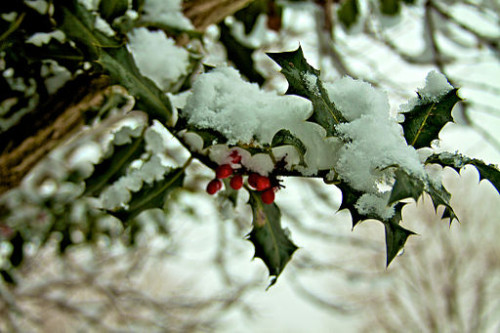This weekend, many Pagans, Heathens and Polytheists in the Northern Hemisphere are marking the Winter Solstice with celebrations, feasts, and rituals. The solstice will occur on Tuesday, Dec 22 at at 04:49 UTC. It is a day traditionally thought to be the longest night and shortest day of the year.

[Photo Credit: McKay Savage / Wikimedia Commons]
Germanic Pagans and modern Heathens celebrate Yule at this time. During this holiday the god Freyr was honored. Several traditions, now commonly associated with Christmas, originated in old Yule celebrations such as eating a ham or hanging holly and mistletoe.
The ancient Pagan Romans celebrated Saturnalia, which typically ran from Dec. 17 through Dec. 23. The festival honored the god Saturn and featured lavish parties and role-reversals. From Saturnalia we can see the traditions of exchanging gifts and decorating evergreen trees indoors. These were eventually adopted as Christmas traditions. Following Saturnalia, there were birth celebrations honoring Sol Invictus (the Unconquered Sun) and Mithras both held on Dec. 25.
Many modern Pagans, including Wiccans, Witches, several Druidic traditions, and their many off-shoots hold this time as one of the eight Sabbats or holy days. Usually called Winter Solstice or Yule, this is a time when many of these traditions celebrate the re-birth of the god by the mother goddess.
And, for our friends and family living in the Southern Hemisphere, it is the time of the Summer Solstice, considered the longest day and shortest night.
Here are some thoughts on the observance of this holiday:
“The solstice season is upon us, and it’s only a couple of weeks before the longest night of the year here in the northern hemisphere. It’s a season of darkness and cold, where we are given the opportunity to find the gifts that darkness brings. It can be hard, when the rest of the world seems to be doing their best to stave off their fear with bright lights, noise and extended shopping hours, but if we are able to push beyond that we can see the sacredness of this holy time, and the exquisite power that it brings.” – Joanna van der Hoeven, From “Darkness and the Winter Solstice”
* * *
“A local Protestant minister, an old man with a booming preaching voice, invoked a father god whose radiance shines down. “Ave Sol Invictus,” I thought, considering that the minister stood in front of a wreath-decorated blazing fireplace, no Christian symbolism in sight. Maybe this was his non-sectarian mode of public speaking, but he talked about this “sacred valley” and the “sacred season” and invoked the ancestors. I felt right at home.”- Chas Clifton, From “Invoking the Birds and Hunting at Yule.”
* * *
“Imagine a Yule ritual with a focus on new year’s resolutions; except instead of pointless promises that are abandoned two weeks into the year, these are powerful vows with the backing of a spiritual entity. An ancestor, spirit, or deity is called to witness the vows (each one by each individual, who would also give Them a suitable offering). Such a thing would require a fair amount of preparation and planning by anyone who would like to participate, but it has the potential to create incredibly strong bonds and powerful experiences.” – Molly Khan, From “Yule is more than the Returning Light.”
* * *
“We sat around the fire for only a half hour or so. The night was thumpingly cold, and smoke kept blowing in our faces. My six year old son and four year old daughter were more interested in jabbing the fire with sticks than in listening to their parents’ makeshift stories about the Man on the Moon and other celestial beings. My daughter singed her hair, and the tip of her mitten melted. Glancing up at the stars and moon, I was suddenly overcome with…
Actually, no word captures the feelings that flooded me, but awe will suffice.” – John Horgan, From “Why a Science Writer Celebrates Winter Solstice”
* * *
“The Winter Solstice is likely humanity’s oldest holy day. As the days shorten and the temperatures fall, Nature whispers a truth: Winter is coming. For those who live in northern latitudes and higher elevations, it’s already here. And it’s going to get worse, even here in Texas. What better time for us to come together and enjoy food and drink and to focus our attention on our families, our religious communities, and our most sacred traditions.” – John Beckett, From “Solstice Morning at Newgrange”
* * *
From all of us at The Wild Hunt, may you have a very blessed solstice, winter or summer, and the merriest of holiday seasons.
![[Photo Credit: Chris Hutchison]](https://wildhunt.org/wp-content/uploads/2014/12/4213268281_a1c484b995_z-500x453.jpg)
[Photo Credit: Chris Hutchison]
The Wild Hunt is not responsible for links to external content.
To join a conversation on this post:
Visit our The Wild Hunt subreddit! Point your favorite browser to https://www.reddit.com/r/The_Wild_Hunt_News/, then click “JOIN”. Make sure to click the bell, too, to be notified of new articles posted to our subreddit.
Just a note. In much of North America Midwinter is the evening of December 21st. http://www.archaeoastronomy.com/2015.html
The winter solstice is not just “traditionally thought” to be the longest night and shortest day of the year; it is an astronomical fact!
I though Saturnalia trees were always decorated outside by the Romans and the practice of doing it indoors was started by German Christians in the 14-1500’s…
Great article in terms of the different views presented.